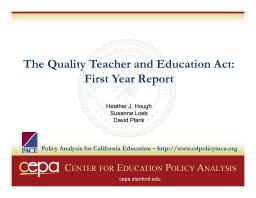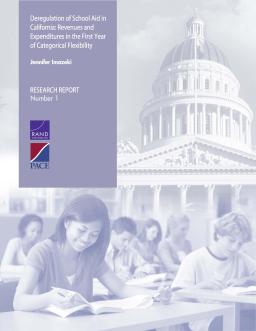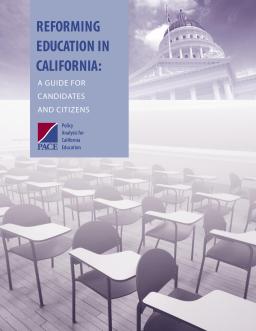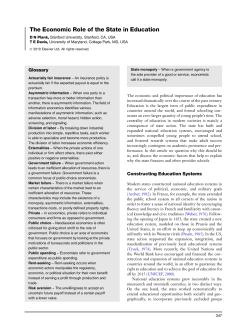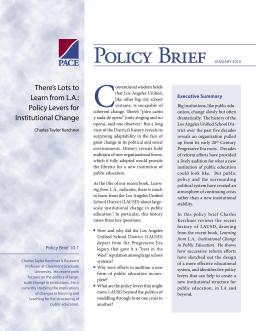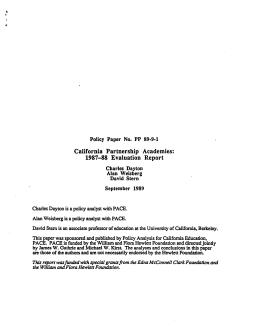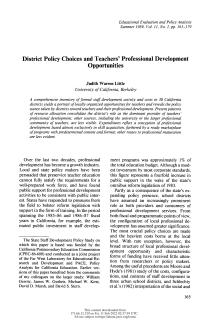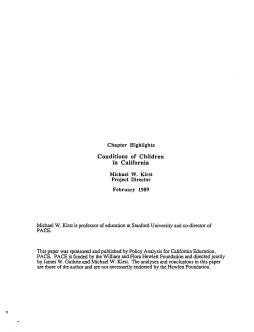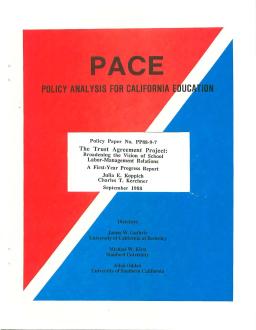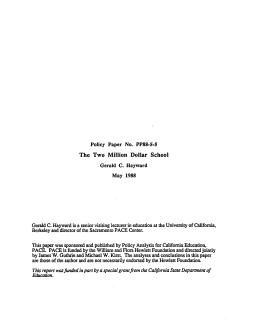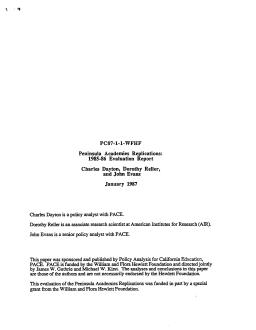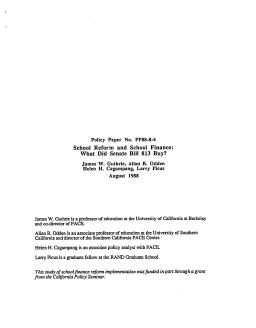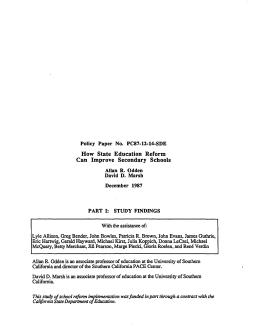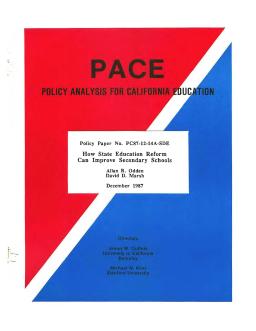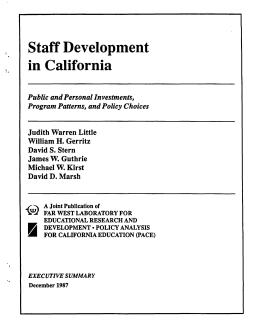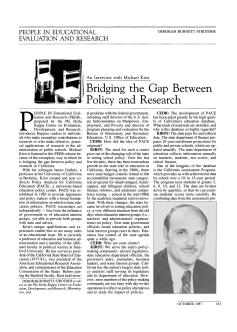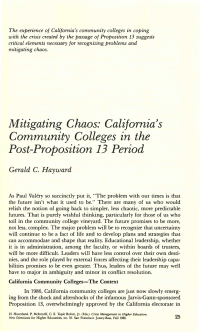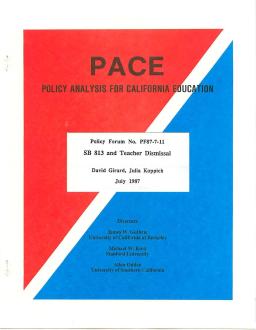First Year Report
Published
Summary
The Quality Teacher and Education Act (QTEA) was passed in 2008 in San Francisco, authorizing $198 per taxable property to be collected by the SFUSD for 20 years. CEPA and PACE collaborated with the SFUSD to evaluate the implementation and impact of QTEA on teacher compensation, support, and accountability. This report documents the first-year implementation of QTEA and its effects on the recruitment and retention of high-quality teachers, improvement of the teacher workforce, and removal of less effective teachers using a mixed-methods approach.
How 10 Districts Responded to Fiscal Flexibility, 2009–2010
Published
Summary
This report explores how 10 California school districts responded to the deregulation of $4.5 billion in education funding, which became entirely flexible in 2009. The study investigates how district leaders made budget decisions and what local factors influenced their responses. The research was conducted by a team of scholars from the RAND Corporation, UC Berkeley, UC Davis, and San Diego State University.
Revenues and Expenditure in the First Year of Categorical Flexibility
Published
Summary
This report discusses the effects of California's partial release of categorical funds to local school boards in 2009. The increased flexibility has provided an opportunity to observe how districts respond to the policy change, but the impact is difficult to isolate as most districts have been struggling to maintain core services during a severe budget crisis. The report includes preliminary results from an ongoing study of district responses to the increased categorical flexibility.
Published
Summary
The James Irvine Foundation sponsors the Linked Learning approach as a strategy for improving California high schools' performance. PACE was asked to gather evidence on the cost of linked learning programs. The report explores how traditional high schools use their resources and how much school districts spend on their high schools to achieve current performance. It proves challenging to judge whether reform strategies like Linked Learning cost more than, less than, or the same as traditional high school programs.
California’s Quality Education Investment Act
Published
Summary
This working paper examines the use of Quality Education Investment Act (QEIA) funds, which allocated $2.6B over seven years to California's lowest-performing schools. The authors conducted a study of four Los Angeles high schools to investigate how QEIA dollars were spent in the first year, who made the decisions, and how funds were used to improve teaching and the instructional program. The study found that district officials and principals had discretion in allocating funds, consistent with recent efforts to deregulate categorical-aid programs and give local educators fiscal discretion.
A Guide for Citizens and Candidates
Published
Summary
PACE has published a policy book to support informed debates about the issues facing California education. The book includes recommendations to improve education quality, targeting resources to those who need it most, giving local schools more flexibility, and designing policies for continuous improvement. While there's no one solution to fix public education, a series of good policies can bring about fundamental reform and improve outcomes for schools and students.
Published
Summary
This article explores the reasons why education has become a central focus of modern societies and the largest public expenditure around the world. The state has built and expanded national education systems, made attending school mandatory, and linked adult success to academic performance. The article delves into the economic factors behind state financing and provision of schools.
Policy Levers for Institutional Change
Published
Summary
The Los Angeles Unified School District has undergone decades of reform, resulting in an unstable atmosphere rather than institutional stability. A recent book, "Learning from L.A.: Institutional Change in Public Education," identifies five policy levers that can create a more effective educational system and a new institutional structure for public education, both in LA and beyond.
1987–88 Evaluation Report
Published
Summary
This report presents findings from the third annual evaluation of Partnership Academy Programs in CA, a high school-based, state-funded program with a school-within-a-school administrative structure that enrolls at-risk students with academic potential. The program provides students with basic job skills in a promising labor-market field and support from local businesses, including curriculum development, guest speakers, field trips, mentors, and work experience positions. The evaluation addresses the quality of program implementation and the degree to which programs follow the academy model.
Issues and Options for Early Childhood Programs
Published
Summary
The growing demand for compensatory education and for child care has generated a rash of federal legislation; many states have enacted new early childhood programs, most of them located within schooling systems, and many others are considering their options. This article examines the basic policy issues governments confront in early childhood education, including the content of programs, their financing, and the inevitable trade-off between cost and quality. The final section of the article outlines the available policy options.
Published
Summary
An inventory of 30 California districts reveals their policy stance on teacher professional development, which primarily consists of skill acquisition through district-led programs. Other sources, such as universities or professional communities, are less visible. The districts are the dominant providers of development opportunities, with expenditures reflecting a ready marketplace of predetermined programs. Alternative routes to professional growth are less evident.
An Exploration of the Debate on School District Size
Published
Summary
The notion that larger school districts are superior has changed, with some researchers advocating for smaller ones. Recent reform reports have focused on the school site as the decision-making seat. Three main issues guide district size research: fiscal efficiency, school effectiveness, and community identity. Although research has been conducted, there is still no definitive answer. This article explores the research and debate on the "right" size for school districts and identifies unanswered questions, hoping to kindle interest in further research.
Chapter Highlights
Published
Summary
This report provides social indicators to evaluate the quality of life for children in California, covering physical and mental health, safety, sexual behavior, academic achievement, and the settings and systems that serve children. Despite most children being healthier and better schooled than in the past, recent polls indicate concern about child-rearing and the likelihood of an expanding educational underclass. The report aims to offer a portrait of the quality of California's children, address gaps in available data, and provide limited policy recommendations.
Broadening the Vision of School Labor-Management Relations—A First-Year Progress Report
Published
Summary
The Trust Agreement Project aimed to develop new forms of school organization and relationships among teachers and administrators. Six California school districts participated, each selecting an educational policy area for trust agreement development. Trust agreements produced role changes, fostered collaboration, and altered decision-making. These initial results show promise in leaping school districts from the 19th-century industrial model to a more appropriate 21st-century model.
Looking Backward and Forward
Published
Summary
1983 marked the beginning of state education reform with the release of the Nation at Risk report. Although many states had already passed education legislation, the last states joined in 1987. The reform's diffusion and breadth is impressive, and its consistency in concept makes it a hallmark in state policymaking. With initial statutes based on the 1983 concepts completed, the question remains whether a second wave will occur or if momentum has been spent.
Published
Summary
In 1987, the Superintendent of Public Instruction released a document detailing the average costs of California schools for 1985-86, providing a brief summary of school expenditures. However, this report lacks in detail, and this report aims to provide more comprehensive and realistic data on school expenditure patterns. The report serves as an analytical base for exploring issues surrounding school expenditures in California, and the data was provided by the state Department of Education staff.
Published
Summary
This article examines whether state-level initiatives for school reform can improve local schools. California's comprehensive reform legislation, SB 813, aimed to alter curriculum and instruction in almost every school in the state. The effects of such a broad range of reforms on local districts and schools are not well understood. While earlier studies indicate that the reforms were being implemented, questions remain about how they operate in local schools and whether they result in substantive change. The answers to these questions are crucial for policymakers and practitioners alike.
1986–87 Evaluation Report
Published
Summary
In the fall of 1985, ten academy programs were established by the State of California as replications of the Peninsula Academies. PACE evaluated these 10 academies in 1985–86. This report presents findings from a second evaluation covering the academies' 1986–87 school year.
Published
Summary
The fourth edition of Conditions of Education in California has expanded its content to include a special features section on education reform processes, along with the previously included sections. The publication is based on compiled information from other sources and original data collection and analysis. The format has been altered to improve readability for a wide range of audiences.
Study Findings
Published
Summary
In 1983, California's Senate Bill 813 aimed to improve the education system by proposing a large number of reforms. However, it lacked a cohesive strategy and proven philosophy. The bill's impact on school districts and schools was unknown, and this study aimed to assess whether selected schools could implement the reform components and whether they contributed to school improvement. The goal was to understand how schools reacted to state mandates and inducements for improvement.
Background and Technical Appendices
Published
Summary
California's education system faced a decline in the early 1980s, prompting reforms such as a common core curriculum, higher graduation requirements, and tougher academic standards. A Nation at Risk report further pushed for nationwide school changes. California's swift response led to the enactment of Senate Bill 813, a comprehensive education reform program with over 80 policy and program reforms. Several studies showed positive results, but the study in this report aims to determine how state-level education reforms improved local schools.
Public and Personal Investments, Program Patterns, and Policy Choices—Executive Summary
Published
Summary
The California Staff Development Policy Study was initiated to assess the possibilities and limitations of staff development in improving classroom teaching and learning. The study aims to answer four questions related to California's investment in staff development, how staff development activities are administered, and how teachers and administrators judge their effectiveness. The study yields eight main conclusions, presented in terms of investment and focusing on improving the capacities and commitments of California's educators.
Bridging the Gap Between Policy and Research
Published
Summary
Michael Kirst, professor at Stanford University and former president of the California State Board of Education, is interviewed by People in Education Evaluation and Research (PEER). Kirst co-directs the Policy Analysis for California Education (PACE) project, an independent education policy center that provides unbiased research to legislators and policy makers. With Kirst's extensive experience in education and government, he is uniquely qualified to understand multiple sides of educational issues.
California's Community Colleges in the Post-Proposition 13 Period
Published
Summary
The passage of Proposition 13 in 1978 sent shockwaves through California's community colleges, affecting all aspects of their operations. The crisis exposed the colleges' lack of preparedness for such magnitude, leaving them grappling to cope with chaos. This article looks at California's experience and highlights critical elements necessary for recognizing problems and mitigating chaos. Educational leadership will need to be adept at ambiguity and conflict resolution as the future promises to be more complex and unpredictable. Finance, mission, and governance are the three key areas of focus.
Published
Summary
In 1985, the Policy Analysis for California Education (PACE) convened a group of attorneys and education policy experts to discuss the effect of Senate Bill 813 on teacher dismissal. They explored varying interpretations of its provisions, contrasted practical experiences with legislative intentions, and outlined recommendations to improve the dismissal process. This summary analysis includes a brief discussion of relevant court rulings and no attempt has been made to update the information since its initial publication.
